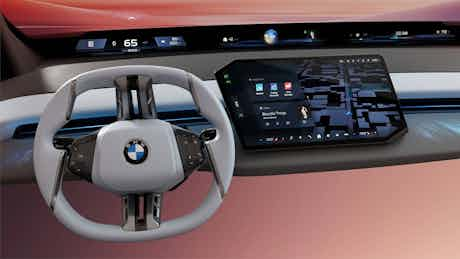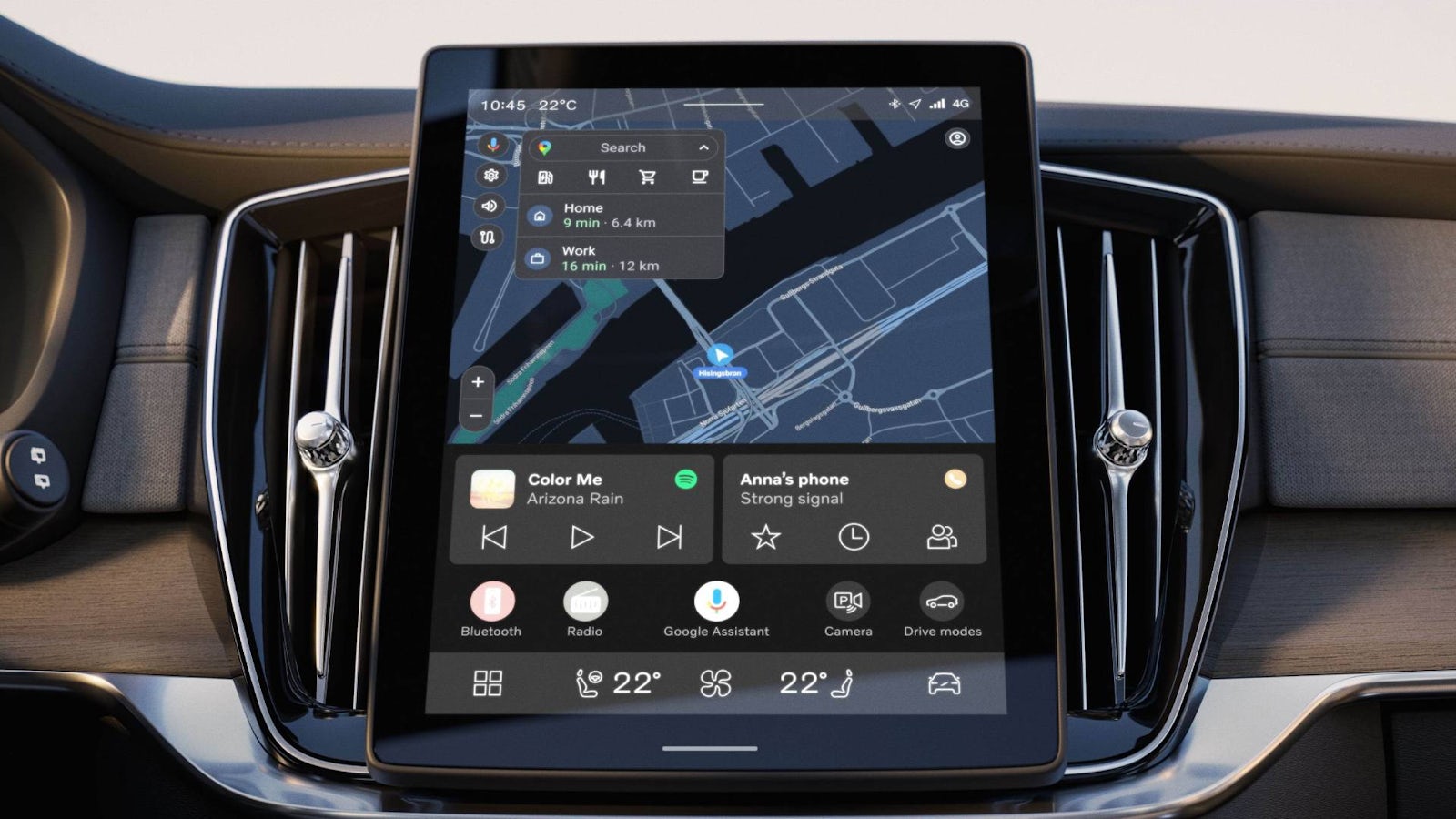What is a car infotainment system?
January 10, 2025 by David Motton

There’s a simple answer to that question and a much longer one. The short answer is that a car infotainment system keeps the driver and passengers informed and entertained. Smash together information and entertainment and what do you get? Infotainment.
What is an infotainment system?
So, here’s the longer answer to the same query. An infotainment system combines many in-car features through a screen in the dashboard. These features may include the stereo, satellite navigation, phone mirroring, heating and ventilation, and more.
Infotainment systems have grown much more sophisticated over the past decade. The typical screen size has grown, and the quality of the graphics has come on in leaps and bounds.

Not all systems are as easy to use as they might be, though. Some modern infotainment set-ups are very complicated, especially if you’re of a generation that didn’t grow up glued to smartphones and tablets.
Go back a few years, and if a car had an infotainment system it was a selling point. Now, all but the most basic models have some form of car infotainment screen. You can even buy aftermarket infotainment systems if your car doesn’t have one.
Choose a higher spec car or tick the right box on the list of options, and you may have a bigger screen or a system with more features. Screens as big as 15 inches across or bigger are available.
Most screens are landscape-shaped. In other words, they are wider than they are tall. Some, such as the systems used by Tesla and Volvo, are portrait-shaped.

A handful, such as the car infotainment system in some BYD electric cars, rotate so the driver can choose between a landscape and portrait orientation.
How does an infotainment system work?
A car infotainment system allows the driver (or passenger) to control various infotainment functions. Most work through a series of touchscreen menus. Others, such as the infotainment systems used in Mazda cars, have a separate controller to navigate the on-screen menus. Some have voice control, and many use a combination of these different methods so that the user can choose the means of control that suits them best.

You could think of a car infotainment system as a tablet computer inside your car. Like a computer, an infotainment system has a CPU (central processing unit) that acts as the system’s ‘brain’, and there’s an operating system in a similar way to a tablet or a smartphone.
Turn on your car, and the infotainment screen typically switches on automatically. It will have a home screen, much like the one on your tablet or phone, from which you can access different menus for all the different functions. Some screens have physical buttons around the outside of the screen for quick access to particular menus, although many modern systems are large enough to include these shortcuts on the screen itself.
What features are available in an infotainment system?
There’s a huge range of features available. These include:
- Satellite navigation
- Digital radio
- Music streaming
- Heating and ventilation
- Parking sensors
- Parking cameras
- Vehicle settings
- Safety features and driver aids
- Hands-free calling and texts
- Smartphone mirroring
Different systems will also vary in how these features are controlled. Depending on the make and model, the system may be controlled by:
- Touchscreen
- Rotary controller/buttons
- Voice recognition
- Gesture controls
One of the most sought-after features is smartphone mirroring. For iPhone users, this is done through Apple CarPlay. If you have an Android phone, then mirroring uses Android Auto. These apps turn the car’s infotainment screen into an extension of your smartphone for easy music streaming, as well as hands-free calls and texting. In fact, there are all sorts of apps designed to be used through smartphone mirroring while driving.
You can also use your phone for navigation with real-time traffic updates, which drivers often prefer to using the car’s built-in system.
Many cars rely on a cable to transfer data from the phone to the car’s infotainment system, but often this can be done through a wireless Bluetooth connection. That way you don’t even need to take your phone from your pocket.
Best car infotainment system
1. BMW iDrive
The latest BMW iDrive infotainment system is as good as it gets. From the moment you thumb the start button, iDrive takes your breath away with the size of the screen, crisp resolution, and the depth of colour.

BMW offers drivers multiple ways to use the system. Tap on the touchscreen, use the rotary controller and shortcut buttons, or try voice recognition – you can even use gesture control for some functions. Despite the system’s complexity and huge number of functions, you don’t need a degree in computer science to use it. That’s important, as it means drivers can use the system without being distracted while driving.
2. Tesla
Tesla goes further with its infotainment system than just about any other manufacturer. There’s no separate driver display for the speedo, and almost no physical buttons. Just about everything is controlled through the touchscreen, even adjusting the door mirrors.
While Tesla has taken its button-hatred to extremes in the Model 3 and Model Y, it’s hard to be unimpressed with the brand’s awesome infotainment system. It does all the important things well, with its crystal-clear display and intuitive operating system. What’s more, it packs in more entertainment features than just about any other system, with video streaming and in-car gaming. You can even play a driving game while you take a break from, well, driving…
3. Renault
Renault has some very clever infotainment systems. The French company has made the smart decision to work with Google to make its latest infotainment system slick and intuitive.
It’s a bit like Android Auto, even before you connect your smartphone. You can download different Google apps, just as you would for your phone, and calling out ‘Hey Google!’ gives you access to all sorts of functions without having to bother with the touchscreen.

You can still connect your phone, and iPhone users aren’t left out – you can switch to Apple CarPlay once your sync your phone if preferred.
Car Infotainment system FAQs
What to do if the infotainment system is not working?
Without wishing to sound like a bad IT department, have you tried turning it off and on again? That may be enough to sort a glitchy system. If the infotainment is still playing up, you may need to reboot the system. Different makes and models will use different methods to reboot the system, for example, you may need to hold the power button down for 15 seconds or so.
Still no luck? Check the fuse box to see if the infotainment fuse has blown. If replacing the damaged fuse doesn’t work, we’d recommend taking the car to a dealer for a more thorough investigation of the fault.
Can I update my infotainment system?
Yes. Many modern systems can be updated ‘over the air’, so the infotainment will notify you through a message on the screen if an update is available. Click ‘install’ and the infotainment will download the latest operating system. With other systems it can be updated when the dealer services the car, or you may be able to do it yourself through a USB port or SD card.
Can I put a new infotainment system in my car?
Infotainment systems are usually built into modern cars. There’s no standard size for an infotainment screen, and infotainment systems tend to be specific to the make of car, so replacing the system isn’t really a DIY job.
On the other hand, if you want to add an infotainment system to a car that doesn’t have one you can buy aftermarket systems that either fit on top of the dash, mount to the windscreen, or replace an old-style DIN radio unit. So, yes, you can put a new infotainment system in your car if it doesn’t have one already.
Cars Change? Carwow!
Looking for a new set of wheels? With Carwow you can sell your car quickly and for a fair price – as well as find great offers on your next one. Whether you’re looking to buy a car brand new, are after something used or you want to explore car leasing options, Carwow is your one stop shop for new car deals.















